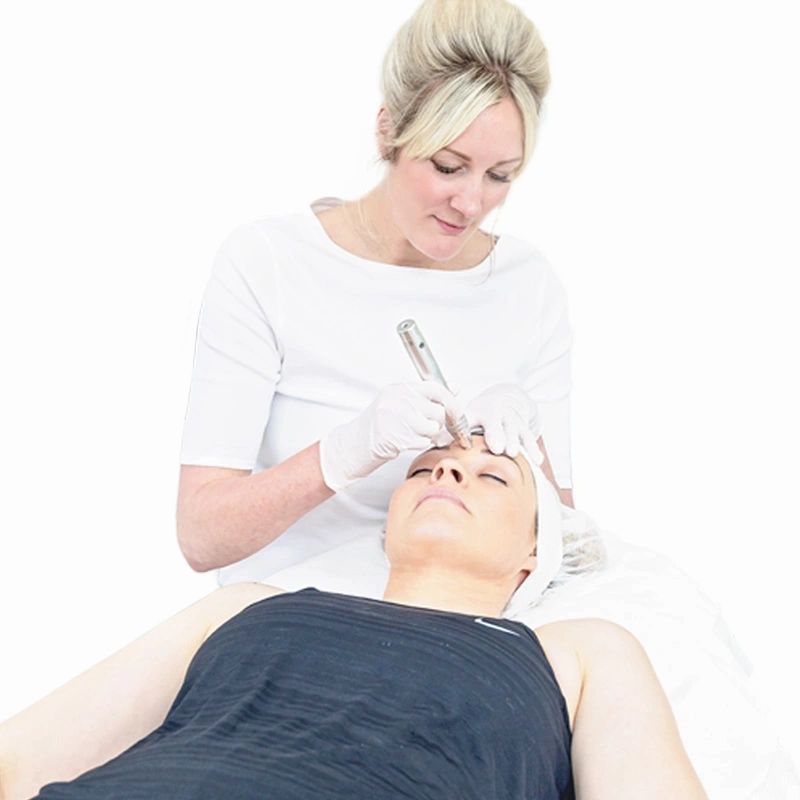
Microneedling - or as it is sometimes known, Collagen Induction Therapy - has been around since the early 1990s and was first used by medics to treat wrinkles and scarring however it has now been widely accepted as a super effective, minimally invasive treatment in the beauty and aesthetics arena for all over skin rejuvenation and to treat a wide variety of conditions. The treatment has advanced in recent years. Traditionally a needle roller was used, then, there were ‘needle stamps’ and then in more recent years a mechanical device known as a needling ‘pen’ was brought to the market. Rollers were first introduced and the treatment was known as Dermal Rollering. The small hand held tool had a rolling head which generally had around 120 needles attached to it which was rolled over the skin. As treatment technology advanced, it was thought that it would be kinder and safer to the skin if the needles were puncturing the skin in a more vertical, perpendicular direction as this wouldn’t cause any pulling or tearing of the skin, as with a rolling needle which enters and exits the skin at a different angles. So the stamping devices were introduced which later evolved to the mechanically stamping needle pens which pulsate up and down at warp speed giving a very thorough, efficient and safe treatment. Microneedling pens now seem to be phasing out the traditional roller and stamps as many more brands are manufacturing their own devices.
Who is it for?
The effects of micro needling can benefit a wide variety of skin issues. It is classed as a regenerative skin treatment and can help any skin condition that is effected by a lack of structural support from dermal ‘scaffolding’ ie collagen. We call it the scaffolding because its basically what holds everything up and in its place, Remember how your skin looked in your 20’s- you had lots of scaffolding back then. so ageing seems the obvious indication for micro needling, however it also shows a significant improvement in acne scarring, general uneven texture as well as pigmentation and low grade non inflamed acne.
The great thing about micro needling is that all of this is possible without actually having to remove any layers of skin as is the case in other treatments such as chemical peeling, making it a preferable choice for people who do not want as much down time.
How does it work?
You know when you graze your knee or burn yourself on the iron, you often find once the injury has healed the skin looks brand new, younger, brighter and smoother. Well it’s this concept of new skin regeneration that makes micro needling so effective.
To understand how it works we must first understand the physiological effects on the skin when an injury or a micro-injury takes place. It is complex and involves a healing process that can go on deep down behind the scenes of your skin for several months, meaning that the benefits also keep building for months following the initial treatment. As the needles are penetrated into the skin causing tiny puncture wounds. It instigates the body’s natural healing abilities. When sensory nerve ending receptors detect this trauma, blood flow rushes to the area (inflammation) and a cascade of events is then triggered in response to this inflammation, lots of chemical messengers swoop in to the scene of the crime and instruct the body to produce a whole host of new cells and the remodelling of the scaffolding (collagen) begins. The earliest collagen formation is collagen type 3 which is laid in the upper reticular layer and papillary layer of the dermis. It is composed of small loose fibres that wrap around the wound site.
After around 6 weeks this collagen becomes larger and forms tighter bundles, this is then known as collagen type 1. This makes up about 85% of a healthy dermis. This remodelling phase can go on for around 12 months and It is this remodelling and rebuilding that makes microneedling so beneficial to skin conditions where the structure has been worn away as in lines and wrinkles, uneven texture or previously damaged skin where a scar has been left. Amazingly it can also be good for red skin conditions such as capillary damaged or vascular damaged areas due to the process of angiogenesis (capillary rebuilding). Hyperpigmentation can also be improved as the pigmented tissues are broken up and renewed. Whats more is that all of these conditions can be further treated if the use of active ingredient based ampuoles are incorporated into the treatment such a those used with the Mesoestetic treatment offered at The Skin Genie Clinic. The use of these actives during treatment allows the active ingredients to penetrate up to 300x more than when used alone. Super active anti-ageing peptides being delivered deep down into the skin- Yes please! I can literally feel my wrinkles soften and my complexion brighten as I write that sentence.
With any type of needling treatment, a progressive approach is always advisable. Starting initially with 0.5 mm long needles to judge how the skin responds and then increasing when necessary. As you progress through your treatment programme, which can be up to 6 treatments for corrective work, and the skin responses have been assessed, adaptations can then be made to the needle depth to accelerate results. Many practitioners make the mistake of thinking the bigger the needle the better, when this is in fact not the case. Going in too aggressively can have a negative impact on long term skin health. Cells within the skin act as communicators and even when a superficial injury is given, the cells in the upper layers of the skin tell the lower layers what has happened and so regeneration takes place throughout..
As we say in industry, effective skin health should take a Progressive approach not an Aggressive one!
Do I need to prep the skin before hand?
If your current skincare routine is non existant or you are a user of face wipes or soap and water then there are a few things you can do to improve your skins ‘readiness’ for treatment and so get the best possible result.
Vitamin C based serums and Hyaluronic acid can help hydrate, repair any oxidative stress and provide an optimum condition for healing and regeneration to take place. Proper cleansing of course and using an effective moisturiser will ensure there is no lipid dryness or areas of impaired barrier which would be easily irritated by this procedure. SPF is also crucial to reduce sun damage and oxidation. Drinking as much water as possible and getting lots of omegas into your diet is also helpful for the hydration and lipidity of the skin. During a treatment programme, recommendations can also be made for more advanced homecare options, thus providing all round improved skin health, condition and appearance.
What about afterwards?
Exfoliation and the use of Retinoids are to be avoided following the treatment and a less is more approach should be followed, gentle cleansing, hydration and sunscreen. A diet rich in protein and anti-oxidants (fruit and veg) will certainly improve the regeneration and rebuilding process, much like how body builders up their protein intake when they require muscles to build, skin is the same.
Does it hurt?
Everyones perception of pain is different, You will certainly be aware of a ‘scratching sensation’ taking place over the skin and your skin can feel slightly warm and tight during the 24-48hrs following the procedure. However numbing cream can be used to alleviate discomfort throughout and I have even had some clients actually fall asleep on the treatment bed. Any opportunity for a nap eh!
To book Microneedling or a general skin health consultation click the link below.

